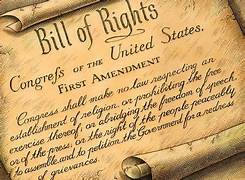Privacy Policy | Terms of Use | Cookie Policy | Disclaimer
Empowering the American middle class — one story at a time.
Constitution & Rights
In the wake of the American Revolution, the newly independent United States faced a crucial task: creating a government that would uphold the ideals of freedom, justice, and equality. The Founding Fathers recognized the need for a robust system that would unite the states while protecting individual liberties. This effort culminated in the drafting of the U.S. Constitution in 1787, a document that would lay the foundation for American democracy.
The U.S. Constitution
In the summer of 1787, a group of delegates gathered in Philadelphia to address the weaknesses of the Articles of Confederation, the first governing document of the United States. What emerged from this Constitutional Convention was a bold new framework for governance: the U.S. Constitution. The Constitution established the structure of the federal government and the relationship between the states and the national government. It set forth a system of government based on the separation of powers, with three distinct branches:
- Legislative Branch: The Senate and the House of Representatives, responsible for creating laws.
- Executive Branch: Led by the President, responsible for enforcing laws and conducting foreign affairs.
- Judicial Branch: The system of courts, responsible for interpreting laws and ensuring they are applied fairly.
The Constitution also outlined the rights of citizens and the principles of democracy. It created a system of checks and balances, ensuring that no branch of government could become too powerful.
The Bill of Rights
While the Constitution provided a framework for governance, many citizens feared that the new government could overstep its bounds and infringe on individual freedoms. To address these concerns, the first ten amendments to the Constitution were added in 1791, known collectively as the Bill of Rights. These amendments guarantee essential personal freedoms and limit the powers of government. Some of the most important rights enshrined in the Bill of Rights include:
- Freedom of Speech, Press, and Religion: Protects the right to express opinions and practice religion without government interference.
- The Right to Bear Arms: Ensures citizens can own and carry weapons for self-defense.
- Protection from Unreasonable Searches and Seizures: Prevents the government from intruding on citizens' privacy without proper cause.
- The Right to a Fair Trial: Guarantees individuals the right to a speedy and public trial by an impartial jury.
- Protection from Cruel and Unusual Punishment: Prohibits the government from imposing excessively harsh punishments on individuals convicted of crimes.
The Bill of Rights not only safeguarded individual liberties but also reflected the Founding Fathers' commitment to limiting the power of government and ensuring that citizens could enjoy fundamental freedoms without fear of government overreach.
The Impact of the Constitution and Bill of Rights
The U.S. Constitution and Bill of Rights are the cornerstone of American democracy. These documents have not only provided a framework for governance but have also helped shape the nation’s identity. Through the Constitution, the Founders created a government designed to evolve with the times while preserving the fundamental principles of liberty and justice.
In the centuries since their ratification, both the Constitution and the Bill of Rights have been interpreted and applied in countless ways, adapting to changing social and political landscapes. They have served as a model for other nations around the world striving to build democratic systems based on the rule of law and respect for human rights.
Why the Constitution & Bill of Rights Still Matter Today
The relevance of the Constitution and the Bill of Rights remains as strong today as it was in the late 18th century. In a rapidly changing world, these documents continue to serve as a shield against the potential abuse of government power and a guide to protecting individual freedoms. From the protection of free speech to ensuring equal justice under the law, the rights guaranteed by these documents are central to the American way of life.
In an era where debates over civil liberties, government surveillance, and individual rights are ongoing, the Constitution and Bill of Rights remind us that the fight for freedom and justice is not a finished story—it is a living, evolving struggle that requires active participation from every citizen.
Conclusion
Understanding the Constitution and the Bill of Rights is essential to understanding what it means to be an American. These documents are not just historical artifacts; they are living blueprints for democracy that continue to shape our nation. As citizens, it is our responsibility to honor and protect the freedoms they guarantee—so that the ideals of liberty, justice, and equality endure for generations to come.

